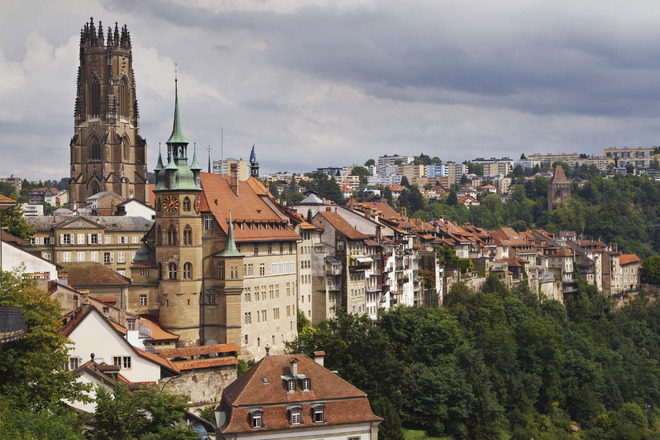Hugh & Colleen Gantzer
The Swiss, like the Punjabis, love good food. In beautiful, old, Fribourg, the efficient Swiss take eating to its logical end as hotelier Peirre tried to tell us, but couldn’t. He introduced himself to us at the funicular rail station, descending into the mist-softened valley of the Sarine river. He smiled and said, “You were at our buffet breakfast in the hotel.” We nodded: the funicular driver was looking impatiently at his watch. We hurried into the small cabin. Pierre called out.
“Enjoy this epicurean town. Even the funicular is elementary”. The doors closed, the funicular began its journey down. “What’s elementary about it?” we asked loudly. “I didn’t say elementary…..” the rest of his words were lost in the rattle of the funicular as it tack-snapped! slowly, into the valley. We filed away our Pierre encounter as one of those strange things that happen to travel writers.
We walked down an 850-year-old street lined with beautiful medieval houses in, what was once, the tanners’ quarter. The city fathers of that age didn’t want the odiferous business of this sector to reach their delicate nostrils! The 13th century cathedral of Saint Nicholas was a soaring, inspiring, example of the best of European religious architecture, particularly its intricately carved Gothic entrance. Sadly, we could not take any photographs inside the church because it was Sunday and Holy Mass was being celebrated in this Catholic town.
We returned to the hotel and then drove to the lakeside village of Murten. In La Schiff restaurant, with a sailing ship as its inn sign, we had our first epicurean experience: an excellent soup, pale perch filleted and fried and fresh from the lake, and a dessert of wild berries and cream. All this with an agreeable chasselas wine from grapes which, according to legend, were brought to Switzerland by the Romans and flourished on slopes warmed by light reflected off Swiss lakes. Wines have their own rich mythology.
Walking down to the lakeside, where visitors fed ducks, grey swans and black swans, we boarded a ferry and chugged across Lake Murten, bobbing with luxury yachts, to Praz. Serried rows of vines stretched over the sunlit slopes of the lake-facing hills. Turning into the village, with its geranium-bright window boxes, we entered a barn-like building with a sign that proclaimed Rouge & Blanc. Our host, Etienne Perrin had trained himself to anticipate international demands for wines from this region, buy direct from the vintners, and sell to consumers under the Rouge & Blanc label.
The evening sun lay low on the lake when we chugged over it again, heading back to Fribourg and Le Café du Midi for a fondue dinner. We were served by two, tall, Ethiopian girls as attenuated and graceful as Brancusi sculptures. The fondue pan is first rubbed with garlic. The cheese is then put into the pan to melt over a spirit stove. The pan, with the bubbling cheese, is laid on the table. Diners tear off chunks of bread, impale these on fondue forks, stir these in the melting cheese till the chunks are well coated with cheese, and eat. Alternatively, small, new, boiled potatoes in their jackets are cut in half and used as the chunks of bread are. We tried both, had the pan replenished with bubbling cheese, and washed it all down with red wine. Without wine…or black tea, for teetotallers ... the fondue will lie heavy on the stomach. That night we wondered what Pierre had meant about the funicular being elementary. Then we fell asleep.
The next day we drove through rolling green farmland. This was clearly dairy country, and even an outdoor restaurant, had fibre-glass cattle daubed in psychedelic colours. The live ones in the black and white uniforms of Swiss, lowland, cows, chomped in the fields or regarded us with heavy bovine disinterest. It was these high-yielding animals that had made such entrepreneurs as Daniel Peter, Francois-Louis Cailler and Henri Nestle establish the Swiss Chocolate Capital in Broc. The Cailler Chocolate Factory is a long, immaculately white building set in a garden against a backdrop of green hills. Inside, guides dressed in cream and chocolate-coloured uniforms escort visitors around on the one-hour tour. The whole, immaculately hygienic place has a faintly rich aroma of creamy milk and chocolate. We saw the whole process from sampling the raw materials in sacks… the hazelnuts were very popular …to the grinding, mixing, blending, moulding. When we had been thoroughly immersed in chocolate lore, we were led through the sample room where visitors can gorge on as many chocolates, of as many flavours and varieties, as they can eat. Even so, we doubt that outsiders can gobble the 11.5 kg of chocolates that every Swiss consumes every year. And yet, they’re so fit. Their alimentary system and digestive process must be unique. That’s when it struck us.
In the funicular we learnt how this unique railway works. The town’s waste water fills a tank below the upper car, and its weight allows a controlled descent, that also pulls up the lower car, before discharging its waste into the sewerage system. The process is then repeated. It had been installed in 1899 and was the only one of its kind still surviving. The so-called ‘waste water’ was not just water, it was the town’s digested waste. Pierre had used the word ‘alimentary’!
Unlock Exclusive Insights with The Tribune Premium
Take your experience further with Premium access.
Thought-provoking Opinions, Expert Analysis, In-depth Insights and other Member Only Benefits
Already a Member? Sign In Now










